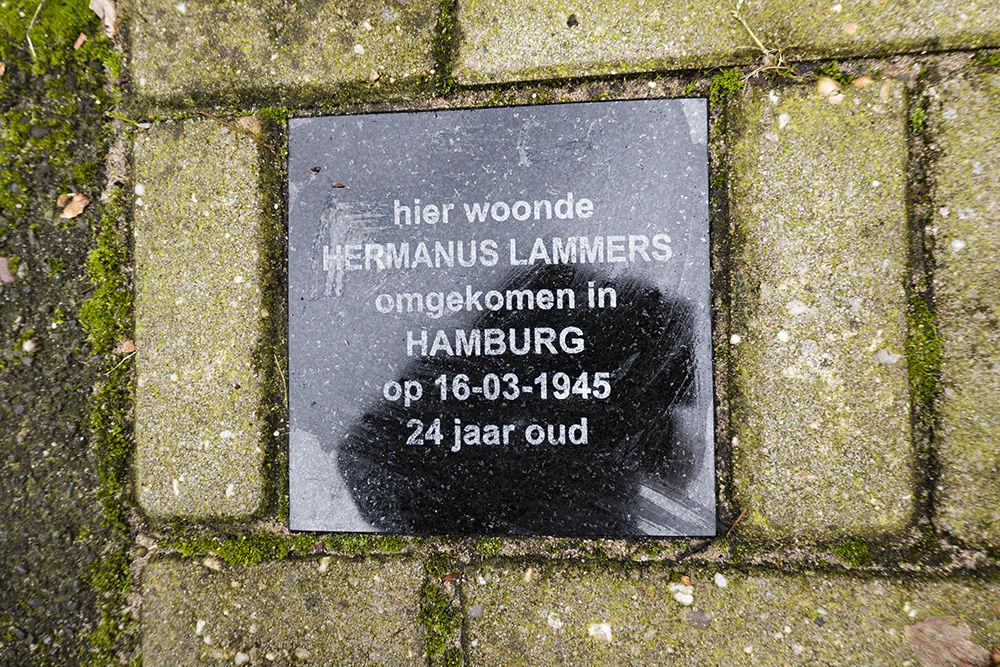Memorial Stone Albert Cuypstraat 21
One Memorial Stone was placed here on 22-03-2017 for:
* HERMANUS LAMMERS (died 16-03-1945, Hamburg, aged 24)
Hermanus Lammers was born on 14 May 1920 in Amersfoort. After finishing school he was apprenticed as a carpenter's assistant. When World War II broke out, Hermanus was still too young to defend his country. From 1942 he was deployed in Germany as part of the Arbeitseinsatz. During a period of leave in the summer of 1944, he decided not to return to Germany. In September 1944, he and a younger cousin of his with the same name – Hermanus Lammers, born in 1922 – found a hiding place on the farm of P. Veenendaal in Achterveld, in the municipality of Scherpenzeel. There, the two cousins helped out a resistance group that operated out of that farm. In addition to the people in hiding, including two Britons, there was also radio equipment that was used to keep the Allies informed about German troop movements. On 15 December 1944, the farm was raided by the Germans. All the men present were taken prisoner. The younger of the two cousins tried to escape, but was shot while on the run. Hermanus ended up in Kamp Amersfoort via prisons in Scherpenzeel and Apeldoorn. There he was offered the opportunity to go back to work in Germany. But because he persisted in his refusal, he was deported on 2 February 1945 to Neuengamme concentration camp near Hamburg. There he was registered on 4 February under camp number 70720. As a prisoner, Hermanus was deployed in the city of Hamburg to clear away the rubble caused by the Allied bombings. Hermanus died on 16 March 1945. His mother and fiancée, Rie Gerritsen, had to wait years for the military police to bring them the bad news. At the family's request, his body was brought to the Netherlands after the war and reburied in Rusthof cemetery in Amersfoort.
This memorial stone commemorates a victim of war who was arrested and died in World War II.
These memorial stones are located here for victims of National Socialism (Nazism). They are often placed as an alternative to the official Stolpersteine of the Gunter Demnig project. Where there is no Stolperstein but people still want to commemorate, a slightly different memorial stone or plague is used. The memorials are in most cases laid in front of a known home address of the victims.
Do you have more information about this location? Inform us!
Source
- Text: TracesOfWar
- Photos: Paul Wareman
- Hermanus Lammers | Herdenkingsstenen Amersfoort
Nearby
Museum
- Museum Flehite - Amersfoort
- National Monument Camp Amersfoort - Leusden
- Dutch Cavalry Museum - Amersfoort
Point of interest
- Lower Cadre School WA - Leusden
- Rosary Camp Amersfoort - Leusden
- Camp Amersfoort - The Morgue - Leusden
Monument
- Memorial "The Big Four" Amersfoort - Amersfoort
- Memorial in Synagogue Amersfoort. - Amersfoort
- Memorial and Bullet Impacts Execution 20 March 1945 - Amersfoort
Cemetery
- Dutch War Graves Roman Catholic Cemetery Amersfoort - Amersfoort
- Commonwealth War Grave Amersfoort Roman Catholic Cemetery Amersfoort - Amersfoort
- Jewish Cemetery Amersfoort - Amersfoort
Remembrance Stone
- Memorial Stone Hobbemastraat 5 - Amersfoort
- Memorial Stone Jacob Marisstraat 10 - Amersfoort
- Memorial Stones Paulus Potterstraat 11 - Amersfoort
Fortification
- Grebbe Line - S3 Casemate GLB10 - Leusden
- Dutch Casemate B5 - Amerfoort
- Remnants Of Tank Barrier - Amersfoort




